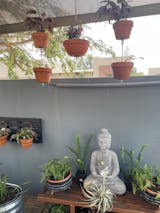
Iris Plant – More than just a master painting
When the Flemish botanist Clusius travelled through Spain in 1564, he was so fixated by the blue Iris xiphium that he sent bulbs back to Belgium, introducing what is known as the Spanish iris to the country. Fast forward to the end of the 19th century when this Spanish variety had spread to the Netherlands and was crossed with Iris tingitana from north-west Africa… The resulting plant, because of its hybridisation taking place in the Netherlands, was immediately known as the Dutch iris, its flower presenting as larger and broader than its two parent plants.
The spectacular iris is a plant that does not easily pass the eye without eliciting a sigh. Even master artists such as Vincent van Gogh have painted these blooms to last an eternity on canvas. Luckily for non-painters, a garden canvas is possible if we plant our irises with care and water them with the regularity they require.
One of 260 iris species, the Dutch iris follows the same form as all other plants in this genus, displaying six exquisite petals (three central, upright ‘standards’; three larger outer ‘falls’ that recurve outward). This species, which falls into the iris’ bulbous category, grows up to 80cm high, a lovely length in a flower bed that allows it to show off its blues, whites and yellows, depending on the type – colours befitting the root of the word ‘iris’, which stems from the Greek word for rainbow.
For natural planting, choose to plant your bulbs at the beginning of May, when autumn temperatures are cooler, as this is not a heat-loving plant at all. This will result in blooms during late September and early October. However, you’re easily able to manipulate this adaptable plant and make it flower in early September if you’d like spring to make itself visible in your garden earlier. Place the bulbs in the fridge for six weeks from mid-March until the end of April before planting them, and the flowers will appear sooner in your garden. The advantage of this is that, because Dutch irises love a cooler climate, they’ll flower for longer at this earlier time of year.
Have you noticed the affinity for the word ‘cool’ associated with these plants? This is why, when it comes to planting them, make sure it’s in a spot where the soil is cool too – not anywhere close to hot paving or touching a north-facing wall, and definitely not in a position that receives full sun. Keep your spot somewhat shaded – overhanging branches work well because they serve the dual purpose of protecting the plants from frost.
As for the soil, ensure it has sufficient compost worked into it, and add more on top of the soil surface so that you have a cooling mulch. Place bulbs 5cm below the ground, 7cm apart from one another, which will allow space for layering with another plant such as the hyacinth, eventually creating a denser display of blooms.
In November, when the foliage begins to turn yellow, it’s time to lift the bulbs. Unfortunately, because of South Africa’s hot spring season, the bulbs generally don’t perform as well during repeat seasons, although small bulblets can be pulled off from the mother bulb for replanting the following year. Store these bulbs at room temperature until autumn comes around and it’s time to start the cycle again.
However, do not fret if your garden is not cool enough for these beauties – you could always just purchase a Van Gogh print and have irises in your sitting room all year round.


September
20 - 21,
2025
Spring Festival
View Event


March
15 - 16,
2025
Dahlia Festival
View Event


Leave a comment